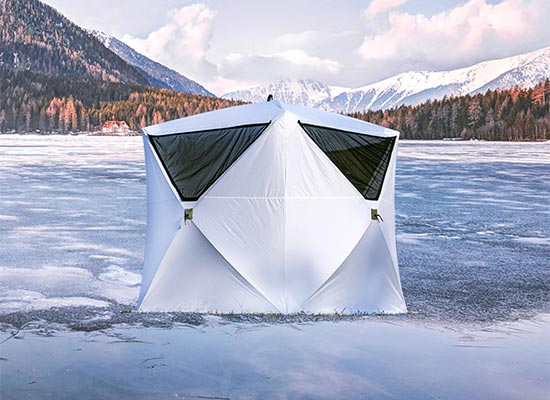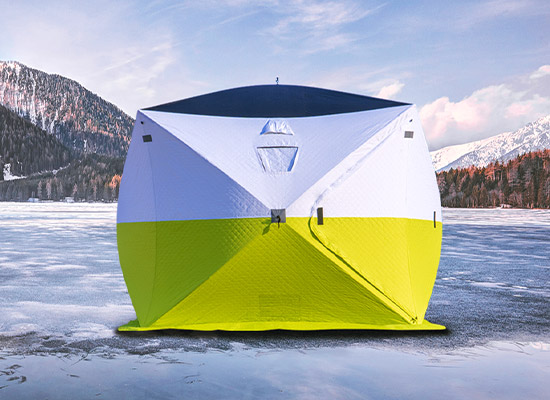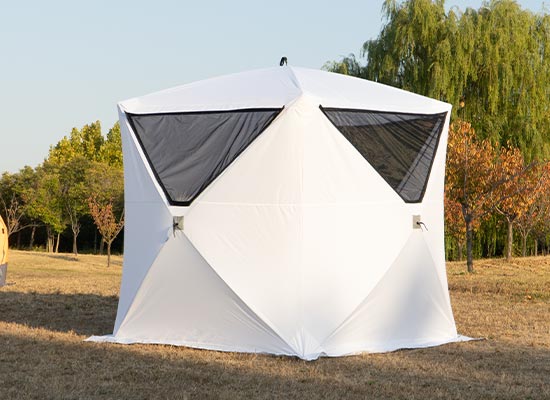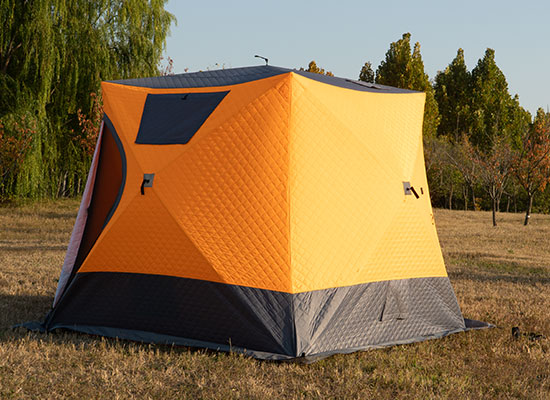Table of Contents
Introduction

Imagine standing on a frozen lake under a pale winter sun, your fishing line cutting through a perfectly drilled hole in the ice. The cold wind sweeps across the surface—but you’re warm, comfortable, and focused inside your ice fishing tent. For anglers, an ice fishing hut isn’t just gear—it’s a portable winter shelter, a cozy refuge against freezing winds and biting temperatures. Whether you’re fishing on Lake Simcoe, the Great Lakes, or a hidden northern pond, choosing and using your tent correctly can make the difference between an enjoyable day and an uncomfortable one.
In this guide, we’ll explore everything from types and materials to insulation, setup, and practical tips to help you find your ideal ice fishing tent.
What Is an Ice Fishing Tent?
A Simple Definition
An ice fishing tent, also known as an ice shelter or ice shanty, is a temporary insulated structure designed to keep anglers warm while fishing on frozen lakes. It blocks wind, retains heat, and allows long hours of fishing in subzero conditions.
Core Elements of an Ice Fishing Tent
A quality tent typically includes:
- Heavy-duty insulated fabric (600D or higher)
- Sturdy fiberglass or steel frame
- Ventilation windows to control condensation
- Anchors and guy lines to resist wind gusts
- Portable carry bag for easy transport
Types of Ice Fishing Tents
Pop-Up Ice Fishing Tent
Fast and easy to deploy, these are great for solo anglers or quick weekend trips. Pop-ups often feature lightweight hubs and quick-lock poles.
Hub-Style Shelter
Built with reinforced hubs at the center, these tents offer excellent stability and generous space. Perfect for groups or longer stays on the ice.
Flip-Over Ice Shanty
These combine a sled base with an integrated tent that flips over in seconds. Ideal for anglers who move frequently between holes.
Insulated vs. Non-Insulated Tents
| Type | Weight | Warmth | Portability | Best For |
|---|---|---|---|---|
| Insulated Ice Fishing Tent | Heavier | Excellent | Moderate | Extreme cold, long sessions |
| Non-Insulated Ice Tent | Lighter | Limited | Excellent | Mild winters, short trips |
Choosing between insulated and non-insulated depends on how long you plan to stay, and how low temperatures drop in your area.
Key Features to Consider When Buying an Ice Fishing Tent

Material & Insulation
A top-tier ice fishing tent should have:
- Water-resistant Oxford fabric (600D–900D)
- PU coating (above 2000 mm) for waterproofing
- Triple-layer insulation for heat retention
Size & Capacity
Ask yourself: How many people will use it?
- 1-2 persons: compact, easy to carry
- 3-4 people: balanced comfort and mobility
- 6-8 person: great for family or group trips
Ventilation & Condensation
Even in freezing conditions, moisture builds up from breathing and heaters.
- Look for adjustable vents on opposite sides.
- Keep small airflow to prevent frost from forming inside.
Anchoring & Stability
When strong winds sweep across the lake, secure anchoring is crucial.
Use ice anchors, wind ropes, and reinforced hub points to prevent collapse.
How to Set Up and Use Your Ice Fishing Tent
Step-by-Step Setup
- Check Ice Safety—Ensure the ice thickness is at least 4 inches.
- Clear the Area—Remove snow or debris before setup.
- Unfold and Secure Corners—Use anchors and tie-downs.
- Inflate or Extend the Frame—Depending on the Design.
- Open Ventilation Windows—Avoid condensation buildup.
Safety on Ice
- Always bring a spud bar and safety spikes.
- Avoid dark spots or cracks on the ice.
- Keep your heater away from tent walls and fuel containers.
After-Use Care
Dry your ice fishing hut thoroughly before packing. Ice crystals or moisture can damage fabric and zippers if left inside the bag.
Staying Warm and Comfortable Inside Your Ice Fishing Tent

Insulation from the Ground Up
Cold rises through ice. To stay warm:
- Use foam or EVA flooring mats.
- Add a thermal layer or carpet under your chair.
- Avoid sitting directly on metal surfaces.
Your Heating Setup
Propane heaters and catalytic units are common—but ventilation is key. Install CO detectors and open vents slightly to allow airflow.
Lighting and Power
Bring:
- LED light strips
- Rechargeable power banks
- Battery-powered lanterns for visibility during night sessions
Maintenance and Long-Term Care
To extend the lifespan of your tent:
- Clean gently with warm water and mild soap
- Avoid detergents that strip coatings
- Store it in a cool, dry place
- Inspect seams, zippers, and hubs before each season
Where to Use an Ice Fishing Tent in North America
Top Ice Fishing Destinations
- Lake Simcoe (Ontario)—famous for perch and trout
- Mille Lacs Lake (Minnesota)—diverse species, strong ice culture
- Devils Lake (North Dakota)—spacious ice fields
- Lake of the Woods (Manitoba)—iconic, scenic, and full of fish
Each site may have unique regulations about shelters, so always check local laws before setting up your ice fishing hut.
Comparison: Ice Fishing Tent vs. Regular Camping Tent
| Feature | Ice Fishing Tent | Camping Tent |
|---|---|---|
| Insulation | Multi-layer thermal walls | Single fabric layer |
| Weather Use | Subzero, windproof | 3-season use |
| Setup Surface | On frozen lakes | On soil or grass |
| Ventilation Needs | High due to condensation | Moderate |
| Floor Design | Often removable or none | Integrated floor |
This comparison highlights why a specialized ice fishing tent is essential for safety and warmth in extreme cold—ordinary tents simply can’t perform under those conditions.
Beyond the Basics: Enhancing Your Ice Fishing Experience

Add-On Elements for Extra Comfort
- Foldable chairs
- Portable stove
- Compact table
- Gear hooks & storage pouches
- Insulated beverage holder
Organization Tips
Use vertical space—hang small tools on tent loops and keep heavy items near the center for stability.
Conclusion
A good ice fishing tent transforms a harsh winter environment into a cozy basecamp. From insulation and anchoring to setup and maintenance, every element matters. If you’re ready to elevate your next trip on the ice, choose a durable, well-insulated model that fits your style and needs.
Looking for professional customization or bulk options? Contact us today to learn how Xingyue can design and manufacture OEM/ODM ice fishing tents built for your winter adventures.
FAQ
How thick should the ice be before setting up an ice fishing tent?
At least 4 inches for walking, and 6-8 inches if you plan to use snowmobiles or heavy gear. Always verify local ice reports.
Can I use a heater safely inside an ice fishing tent?
Yes, if it’s a certified portable propane or electric heater. Always keep a vent open and use a carbon monoxide detector.
What’s the best way to prevent condensation inside my tent?
Use cross-ventilation by opening two opposite vents slightly, and avoid boiling water or wet clothes inside.
Are insulated ice fishing hut worth it?
Absolutely. They trap heat better, reduce condensation, and save fuel. Ideal for multi-day or extremely cold trips.
How do I clean and store my tent after fishing?
Brush off ice, let it fully dry, then store it loosely folded in a cool, ventilated space.
What’s the difference between a pop-up and flip-over ice fishing hut?
Pop-ups are lightweight and quick to set up, while flip-overs have sled bases for easier mobility—great for anglers who move frequently.
